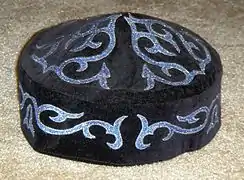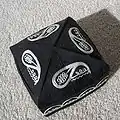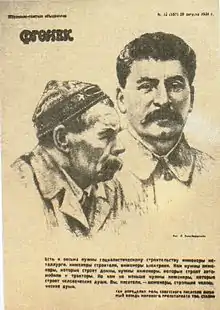Tubeteika
A tubeteika (Russian: тюбете́йка) is a Russian word for many varieties of traditional Central Asian caps. Tubeteikas are today worn in Tajikistan, Kazakhstan, Kyrgyzstan, and Uzbekistan, as well as in Muslim-populated regions of Russia (mainly Tatars) and Azerbaijan. The skullcap worn by Uzbeks and Uyghurs is called a doppa and has a square base. It was a popular headgear among children throughout the USSR during the 1940s and 1950s.

Tubeteikas are worn typically by the Turkic ethnic groups of the region. It bears some superficial resemblance to the yurt, another Central Asian cultural icon.
The -ka at the end is a Russian diminutive suffix, as with shapka, ushanka and budenovka. In Turkmen, it is called tahiya ("taqiyah").
Doppa
The Uzbek doppa or duppi (Uzbek: doʻppi) is considered an applied art form and an important part of the traditional folk costume.[1] Black with a flat, square base,[2] In Chust, Uzbekistan, the caps are made with white embroidery with "four arches [which] represent impenetrable gates that will keep all enemies at bay; the burning peppers protect against the evil eye; and the almonds or bodom are said to symbolise life and fertility".[3]
Also, there is a trend among Sephardic and Moroccan Jews to wear Uzbeki tubeteikas as a kippah.
Gallery
 A Kyrgyz tebetey
A Kyrgyz tebetey A Crimean Tatar tubeteika.
A Crimean Tatar tubeteika. A Kyrgyz "topu"
A Kyrgyz "topu"
 Cover of Ogoniok featuring Maxim Gorky wearing a tubeteika.
Cover of Ogoniok featuring Maxim Gorky wearing a tubeteika.
References
- "Tubeteika suits everybody". Archived from the original on 28 September 2007. Retrieved 11 July 2011.
- Mentges, Gabriele; Shamukhitdinova, Lola (2013). Modernity of Tradition: Uzbek Textile Culture Today. Waxmann Verlag. p. 115. ISBN 978-3-8309-7906-7.
- Lovell-Hoare, Sophie; Lovell-Hoare, Max (8 July 2013). Uzbekistan. Bradt Travel Guides. p. 117. ISBN 978-1-84162-461-7.
